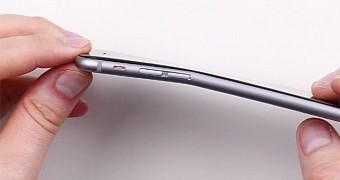Long-time tech watchers might recall that Apple’s iPhone 6 Plus had a bug that eventually became famous as the Bendgate, as the device was bending under moderate pressure, obviously experiencing physical damage.
And it turns out that Apple liked that so much that it’s now trying to make it a feature, as the company was recently granted a patent for a technology that would ultimately lead to a bendable iPhone.
Patently Apple reports that Apple applied for the bendable and foldable screen technology three times, but the company actually got rejected the first two times. But it looks like Cupertino has finally managed to get the patent for the technology it has been working on since at least 2013.
The patent includes all the technical details to explain how a bendable screen would work, but it looks like it’s essentially a new technology that would be based on conductive carbon nanotube structures that are flexible and can resist to cracks and strong pressure.
Apple wants a bigger overhaul of the iPhone
While it’s worth mentioning that patented tech doesn’t always reach production, it wouldn’t be surprising to see a bendable iPhone on the market in the coming years, especially because Apple is looking into ways to overhaul its flagship product to keep up with competition from Android manufacturers.
Ceramic is believed to be one of the materials that could contribute to the creation of this new iPhone, and Apple has already invested in this field, with the recently-launched Apple Watch Series 2 coming with a version entirely made of ceramic.
The next-year iPhone is also expected to represent a major overhaul of the existing generation, as Apple celebrates the 10th anniversary of the device and wants the model to be an entire redesign. People with knowledge of the matter indicated that Apple could aim for a new glass-based design that would come with no bezels and all front-facing parts integrated into the screen, including the Home button and the fingerprint sensor.
It goes without saying that there are only slight chances to see the next iPhone adopting technology described by this patent, but it’s better never to say never.

 14 DAY TRIAL //
14 DAY TRIAL //